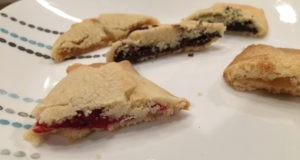 “I know it’s been year-round since the 1970s, but before that, it was maybe a month total: February until Purim, and maybe a little after,” said Brad Hall, the long-time manager at the venerable St. Paul institution. “We didn’t add more flavors until 30 or so years ago. It was poppy and prune.”
“I know it’s been year-round since the 1970s, but before that, it was maybe a month total: February until Purim, and maybe a little after,” said Brad Hall, the long-time manager at the venerable St. Paul institution. “We didn’t add more flavors until 30 or so years ago. It was poppy and prune.”
Now, the case rotates around a dozen or so flavors with almond being among the most popular. They also have apricot, apple, raspberry, cherry, and chocolate. Hall says they’ve tried others, but they haven’t taken off.
“You have to change,” Hall said of the decision to make them year round and add flavors. If you don’t change, you die. We had to make those different kinds.
“The Chocolate took us months to figure out how to do it. Regular chocolate off the shelf melts and the pastry doesn’t cook. So it’s more like a brownie.”
Some fruit flavors like blueberry, pineapple, and lemon haven’t been as successful.
“Some work, some don’t catch on, and others aren’t worth it by the time you mess around,” he said. “The blueberry doesn’t taste great with the dough. We couldn’t sell strawberry or the lemon. It’s why we’ve had stuff on the menu forever, and other things we’ve had to make changes to.”
A recent taste test of five different flavors of hamantaschen – apple, almond, cherry, poppy, and chocolate – found mixed results (based solely on the tastes of the participants: myself, my wife, Ilyse, and our 12- and almost-8-year-old daughters), and some interesting observations on how they compare in the eye-test to other options.
What our tasting panel found interesting was how the filling managed to spread throughout the inside almost all the way to the corners. So unless you nibble at the corners, virtually every bite gives you filling. My assumption was that the filling is spread throughout the dough before baking, but Hall set me straight.
“If you spread it first, it oozes out,” he said. “Put a dollop in the middle, it spreads throughout in the oven.”
The almond had a strong almond extract taste – which is very different from fresh almonds, although Hall said he doesn’t think they add any. The almond paste is cooked down to almost a caulk texture, that brings out a lot of the natural oils of the nut. He said it’s similar to a bear claw, but with less sugar.
Hannah, my 12-year-old, likened the taste of the almond hamentashen to a biscotti. Emma, like many kids, was drawn to the chocolate, but also liked the cherry.
“It has chunks of cherry in it. It tastes really sweet – in a good way,” she said.
A strong observation on the cherry. Hall said the cherries are halved – as opposed to the raspberry hamantaschen, which are pulverized. The way the fruits are treated depend on how they react with the dough.
Any good hamantaschen starts with the cookie. Hall said they start with a disc that is about 4-to-5 inches in diameter with a dollop of the filling in the middle. Then you fold over the corners and you have your triangle. Hall said they sprinkle sugar on the raspberry hamantaschen to tell the difference between that and the cherry, and cinnamon on the apple to tell it apart from the apricot.
“It’s very technical,” he said.
The cookie is a cross between a sugar cookie and pie crust so it can be easily manipulated once the filling is in.
“The flavor of the fillings don’t permeate too deeply,” he said. “If you break a piece off the edge, you can get a piece without the filling.
Ilyse said that the filling in the apple hamantaschen complimented the cookie the best of the ones we tried, and from a taste standpoint, had the consistency you’d expect from the apricot hamantaschen.
With Purim ahead, this weekend, ovens all over town will fire up to make homemade hamantaschen. If baking isn’t your strong suit, swing by the Highland landmark. You could do a lot worse this weekend.
















